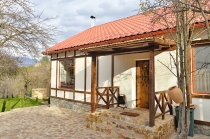
Marriott Tsaghkadzor
The hotel complex "Marriott Tsaghkadzor" offers a comfortable stay in the fresh air of Tsaghkadzor,...
Golden Palace Resort
"Golden Palace Resort-Spa" is the only officially recognized 5-star hotel in Tsakhkadzor, in...
Elegant
Elegant" hotel has stylish rooms where the guests can enjoy picturesque view of mountains and...
Villa Jrhogher
"Villa Jrhogher" is situated in the heart of Dilijan’s forests and is a perfect choice for a small group of friends, colleagues or family members to host up to 10 guests. Free private parking...France
.jpg&width=385&height=237)
| Capital | Paris |
| Area | 547 030 km² |
| Population | 60,2 million people |
| Official language | French |
| Currency | euro |
| Climate | summer +23°C winter 0°C |
| Recommended type of holiday | sightseeing beach vacation |
About country
France - the world's most popular tourist destination - can confidently claim to offer it all, from glamorous beaches and storybook castles to panoramic countryside and city chic. It's a country of dramatic juxtapositions - the expansive boulevards of Paris, the timeless greenery of the Loire Valley, the wide slopes of the Alps, the lavender fields of Provence, the gourmet restaurants of Lyon, the rugged charm of Corsica - and one which, when taken as a whole, presents a near-perfect visitor package.
Paris itself is one of the globe's truly great cities: a multi-layered realm of high fashion, historical riches and haute cuisine. But seen in a wider context, it's just one of many world-class tourist destinations that France has to offer. "How could one describe a country which has 365 kinds of cheese?" once asked former French president Charles De Gaulle. It's a good question.



Sightseeing
France has a proud café culture, and people-watching over a coffee and croissant is a quintessential way to pass the time. If you're looking to imbibe something with a bit more pep, move on to a pastis.
What better way to take in the medieval chateaux and sparkling wine caves of the Loire region than on two wheels? The gentle pace of life here has drawn countless artists and writers over the years - and plenty of cyclists too.
Considered by many to be the most impressive river gorge in Europe (others have it as France's answer to the Grand Canyon), the Gorges du Verdon reaches heights of up to 700 metres (2297ft) at its deepest, its steep banks blanketed in greenery.
There's a great deal more to France's second-largest city than its fabled restaurant scene (although miss that at your peril, foodies) - art museums, a vibrant clubbing scene, riverside walks and a historical old town all add to its considerable appeal.
Anywhere that boasts the Louvre, the Eiffel Tower, the Arc de Triomphe, Sacre-Coeur and Notre Dame Cathedral (and they're just the hors d'oeuvres) is more than just another city. Equal parts chic, edgy and drop-dead beautiful, Paris is cosmopolitan, ever-changing and unmissable.



Traditions
A tradition that is popular at weddings is beheading bottles of champagne using a specially-made saber. The tradition originated in the time of Napoleon when the Hussards under the famous general's command began celebrating victories by swinging a sabre and thus neatly slicing the top off a champagne bottle. According to legend, the Hussards, skilled cavalry, would ride up at full gallop to one of the ladies holding up the bottle and with one swipe, behead the bottle.
Many old French traditions are related to the holiday season. Holding a puppet show on Christmas eve is very common and later at midnight, people attend church for the traditional Christmas Mass. After mass, they have a late Christmas Eve dinner, called le Réveillon (referring to the wake up or revival, alluding to the birth of Christ). Menus for this occasion change according to the region you are in but will usually consist of dishes containing turkey, capon, goose, chicken, and boudin blanc (white sausage).
Children wait for Père Noël (Santa Clause) and leave their shoes out in front of the fireplace, doping presents will fill them by morning. The tree is hung with nuts and candy. Children also believe in Père Fouettard who hands out spankings for anyone who's been naughty.
Called Pâques in France, this is a very important time for the French, who have a strong Christian, and especially Catholic, background. According to tradition, no church bells are rung on the Thursday before Good Friday and remain silent for several days, until on Easter Sunday, they revive. As the bells toll, the custom is for people to hug and kiss each other.
Children don't look for eggs left by an Easter Bunny… rather, the French believe that the Flying Bells leave on the Thursday before Good Friday, taking with them all the grief and misery of mourners of Christ's crucifixion, reaching Rome to see the Pope and then come back on Easter Sunday morning bearing chocolate easter eggs, which are hidden around houses and gardens for children to find.



Cuisine
From the baking aromas wafting from a village boulangerie to the Michelin-starred allure of a gourmet restaurant, food in France has that je ne sais quoi that sets it apart from, well, almost everywhere. While the archetypal French dish is fabulously rich, the national cuisine is as varied as the country's landscape, and much of its prestige comes from the quality of its regional specialities. And did we mention the cheese? Bon appétit.
Specialities:
• Bouillabaisse (fish stew, usually containing at least types of fish and shellfish. Usually served with bread).
• Cassoulet (rich haricot bean casserole, often slow-cooked with various meats including duck, goose and pork sausages).
• Quenelles de brochet (pounded pike formed into sausage shapes and usually served with a rich crayfish sauce).
• Soufflé au Grand Marnier (light and fluffy dessert flavoured with orange liqueur).





